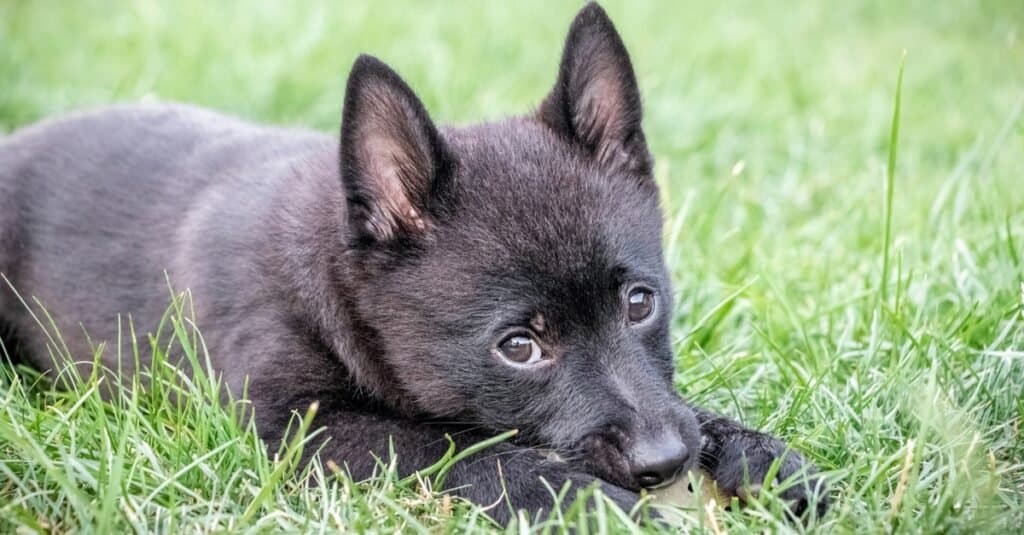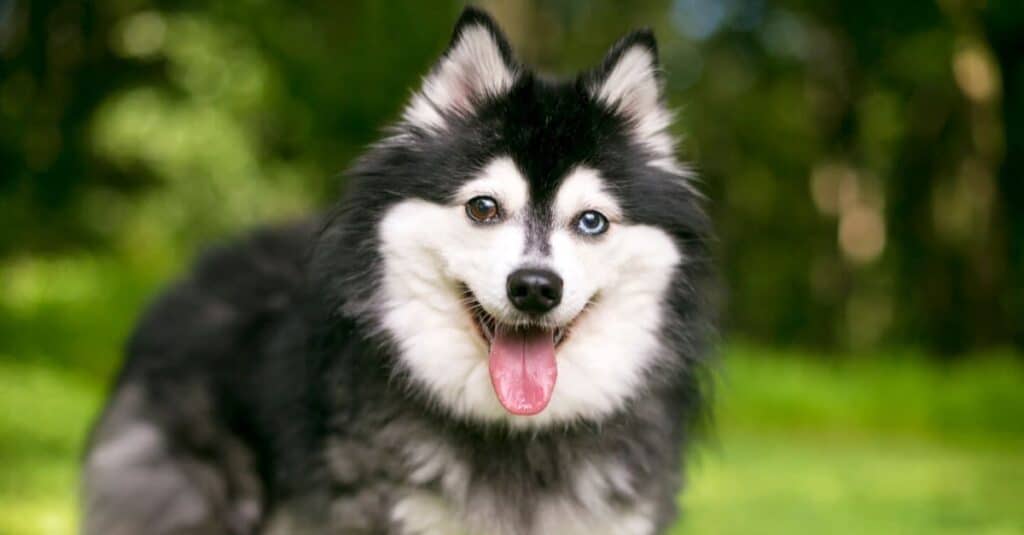While people sometimes mistake the klee kai for miniature huskies, the miniature husky vs. klee kai are separate breeds. Breeders set about creating the Klee Kai from the spitz-type dog in the 1970s, but the Miniature Husky is not an official breed. Instead, the mini husky describes a small husky-type dog that may result from crossbreeding between a Siberian or Alaskan husky and another small species, such as a Pomeranian or Shiba Inu.
Comparing Miniature Husky vs. Klee Kai
IMAGE ONE – IMAGE OF MINIATURE HUSKY AND KLEE KAI (CAPTION – Miniature husky vs. klee kai means weighs of up to 35 lbs. vs. 20 lbs, 16 inches vs. 17 inches, and an unregistered breed vs. a recognized breed.
| Miniature Husky | Klee Kai | |
| Breed History | Siberian/Alaskan Husky and Pomeranian or Shiba Inu | American Eskimo Dog and Schipperke |
| Size | 12 -16 inches | 15 – 17 inches |
| Weight | 15 – 35 pounds | 20 pounds |
| Appearance | Fur – black and white, grey and white, and red and white. Eyes – brown, blue, bi-eyed, or parti-eye. | Fur – black and white, grey and white, red and white, sage and white, or all white. Eyes – blue, brown, bi-eyed and parti-eye |
| Personality | High energy levels Social Destructive behavior when bored Boisterous | Great companion dogs Calmer Aloof or shy Can suffer separation anxiety Intelligent |
| Price | $950 – $1,450 | $1,500 to $3,000 |
Miniature Husky vs. Klee Kai: Breeding Histories

The klee kai breed comes from the Schipperke (above), the American
Eskimo dog
, and the Alaskan husky. The mini husky is a smaller version of the standard Husky.
©Jaroslav Machacek/Shutterstock.com
Klee kai are not miniature huskies bred to be smaller in size for apartment or city life, contrary to popular belief. While klee kai is a breed that the United Kennel Club and the American Rare Breed Association recognize, miniature huskies are not an official breed. Additionally, the Alaskan or Siberian Husky, from which the mini husky hails, are not seen as purebred dogs.
Breeders created the klee kai during the 1970s in Alaska as a companion-sized dog to resemble the popular Alaskan Husky but without the high drive associated with that working dog. Three foundation dogs form the basis of the klee kai: an Alaskan husky, a Schipperke, and an American Eskimo dog.
There are now three size varieties of klee kai — Standard, Miniature, and Toy — but the two major kennel clubs recognize only Standard and Miniature. The Toy variety is too new to have gained much recognition yet. While all three size varieties share many physical and personality traits with their larger cousin, the Alaskan husky, they are very much their own distinct breed.
Miniature Husky vs. Klee Kai: Size
The mini husky is a miniature version of the better-known Alaskan husky, while the klee kai is closely related to the American Eskimo dog and schipperke. These two breeds of dog have some notable differences in size. The mini husky typically stands 12 to 16 inches tall at the shoulder and weighs between 15 and 35 pounds. The klee kai, in contrast, is usually 15 inches to 17 inches tall and about 20 pounds in weight.
While both breeds are small dogs, the mini husky is typically slightly smaller than the Klee Kai. These size variations might be partly because the mini husky is deliberately bred to be a smaller dog. In contrast, the klee kai is bred to closely resemble the akita or similar spitz dogs in size and appearance. Whatever their size differences, the miniature husky and klee kai make excellent companion animals.
What is the Difference Between a Husky and a Miniature Husky?
Miniature Huskies differ from their standard counterparts primarily in size. They are typically half the size, with a weight range of about 15 to 35 pounds and a height of 12 to 16 inches. In contrast, standard Huskies weigh between 35 and 60 pounds and stand 20 to 23.5 inches tall.
Miniature Huskies tend to exhibit shorter fur, often displaying a combination of black, white, and gray colors. In contrast, standard Huskies come in a wider array of colors, more so than their miniature counterparts.
Additionally, it’s worth noting that miniature Huskies may have unique eye colors, these characteristics are less common in standard Huskies.
Klee Kai vs. Miniature Husky: Appearance
In contrast to the miniature husky, the klee kai only come in three colors: black and white, grey and white, and red and white. However, all three colors of klee kai can have blue, brown, bi-eyed, or parti-eye eyes. On the other hand, miniature huskies come in a greater variety of colors, including combinations of white and black, white and gray, red and white, sage and white, or all white. They, too, can have blue, brown, bi-eyed, or parti-eye eyes.
Both breeds are recognizable for their trademark face masks, striking eyes, bushy tails, and plush fur. Therefore, the main difference in appearance between these two breeds is the size and color.
Klee Kai vs. Miniature Husky: Personality and Temperament

An Alaskan klee kai vs. mini husky — either way, both need plenty of physical stimulation and exercise.
©Mary Swift/Shutterstock.com
Klee kai are bred to be companion animals and love human interaction. They might be shy around strangers but are incredibly attached to their family pack. Consequently, they are prone to separation anxiety if you leave them alone for long periods. It is, therefore, a good idea to socialize them from a young age. In addition, klee kai are highly intelligent, so you can train them to perform tricks and participate in agility courses.
Mini huskies are high-energy dogs that will require a lot of exercise to deplete their energy levels. They like to run with their owners and are social dogs that enjoy the company of other dogs and humans. However, they can also be boisterous when it comes to playtime and may resort to some destructive behavior when bored. So, it is essential to ensure they get plenty of exercise and mental stimulation.
Price: Alaskan Klee Kai vs. Miniature Siberian Husky
Klee kai prices vary greatly depending on their coat color, eye color, and size. Different breeders will charge different prices; however, they typically fall in the range of $1,500 to $3,000. Mini huskies are, in contrast, less expensive, costing $950 – $1,450 on average. You may have difficulty locating a breeder near you, but it is also true that klee kai and mini huskies are not an ordinary dog breed.
You should buy both breeds only from an established breeder with a reputation for ethical breeding. Additionally, be prepared to wait months for your dog as ethical breeders do not overbreed their animals. But the wait will be worth it; you will have a lifetime companion that is also beautiful and unique.
The photo featured at the top of this post is © bon9/Shutterstock.com
Ready to discover the top 10 cutest dog breeds in the entire world?
How about the fastest dogs, the largest dogs and those that are -- quite frankly -- just the kindest dogs on the planet? Each day, AZ Animals sends out lists just like this to our thousands of email subscribers. And the best part? It's FREE. Join today by entering your email below.
Thank you for reading! Have some feedback for us? Contact the AZ Animals editorial team.






